I have too many projects going on, that’s all there is to it. But, I’ll still circle back to the ones that seem to have disappeared, at least now and again. You’d think, as much as I love soup, that The Bread & Soup Project would stay front and center, no?
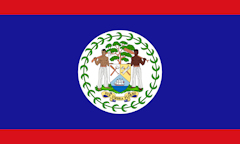 So, what do we know about Belize? When I was growing up, this place was called British Honduras. It was a colony of the UK until 1964, when it became a self-governing colony, but still a colony. It was renamed Belize in 1973, but it wasn’t until 1981 that it became an independent country. It has/had the dubious distinction of being the last continental possession of the UK in the Americas (there are still non-continental colonies, i.e., islands). It’s the only Central American country where English is the primary language (we have on in South America too, can you name it?). There are several theories about the etymology of the name, taken from the country’s major river, the Belize, the most popular, though unproven one, being that it came from a Mayan word, belix, which meant “muddy waters”.
So, what do we know about Belize? When I was growing up, this place was called British Honduras. It was a colony of the UK until 1964, when it became a self-governing colony, but still a colony. It was renamed Belize in 1973, but it wasn’t until 1981 that it became an independent country. It has/had the dubious distinction of being the last continental possession of the UK in the Americas (there are still non-continental colonies, i.e., islands). It’s the only Central American country where English is the primary language (we have on in South America too, can you name it?). There are several theories about the etymology of the name, taken from the country’s major river, the Belize, the most popular, though unproven one, being that it came from a Mayan word, belix, which meant “muddy waters”.
The country encompasses 8,867 square miles (22,966 square kilometers), putting it roughly the same size as New Jersey, though with a population of about 388,000, it’s far less densely populated (NJ has almost 9 million). The food has numerous influences, not surprising for a country with its history, and has been described as Mexican-Central American meets British-Jamaican.
After much faffing about, I decided on Serre for the soup, and Panades for the empanada-ish accompaniment.
The panades are relatively simple to make. The dough is a cornmeal based one – after an aborted attempt with coarse cornmeal on its own that simply wouldn’t hold together, I went with a half and half blend of finely ground cornmeal (pretty much instant polenta) and pastry flour. A cup and a half of each, plus a teaspoon each of annatto or achiote powder (basically for the coloring) and baking powder. Just water to bring it together. The most common fillings seem to be either canned tuna or refried beans. Since I was making a fish soup, I went with the latter.
Okay, for all those of you looking for “what to give Dan as a gift, he has everything for the kitchen already?” – I don’t have a tortilla press. So I rolled these out by hand. This quantity of dough made 18 tortillas, or panade masas. I ended up opening a second can of refried beans to have enough to give them a decent amount of filling.
The dough does tend to be a little crumbly, and there’s some cracking going on. Probably just an adjustment in the amount of water in the dough. Then, they get fried. Traditionally, I gather, in coconut oil, but I used vegetable oil, as do, probably, most people in Belize these days simply because of economics.
Panades are accompanied by a traditional spicy cabbage slaw – basically just chopped cabbage, onion, and chili (habaneros are de rigeur, but we don’t have any, so I used a rocoto for that similar fruitiness, and added about an 1/8 tsp of habanero chili powder – I didn’t want it too hot as I knew we had guests coming for dinner), plus lime juice, vinegar, salt and pepper. Basically, did the whole thing pulsed in the food processor, in about a minute.
Add the liquids and let it sit for an hour. Yum! I’m going to use that again, for something.
Okay, onto the serre, a word from the Garfuna tribe that traditionally inhabited the area, and basically meaning a soup of fish cooked in coconut milk. We have here… coconut milk, green plantains, taro root, cassava root, bell peppers, cilantro, onion, rocoto (again, in place of habanero), garlic, salt, pepper, and cumin, and fish steaks, in this case, surubí, or tigerfish. Using a freshwater fish probably isn’t traditional, but it is a firm fleshed, slightly oily fish, and it was available in “steaks” in the fish market, so it fit the bill.
Food processor again, peppers, onions and garlic, plus the spices, into a big pot. No cooking yet – as it turns out, this is a pretty much, dump everything in and let it go (except the fish and cilantro) type of soup.
Peel the two roots and the plantains and cut into bite sized chunks. Add to the pot, along with the coconut milk (given how much I was preparing, I ended up adding a second coconut milk to the pot. Then top with water, bring to a boil, reduce heat, and simmer about half an hour until the vegetables are cooked through.
As the half hour counts down, fry the fish steaks, lightly browning them on both sides, and then nestle them into the soup to finish cooking for about another 5-10 minutes.
Add the cilantro and you’re ready to serve! A fish steak plus a ladle-ful or two of the soup into each bowl. Often accompanied by a little garnish of fresh chilies and raw onions with a squirt of lime juice, I just put lime wedges and some chopped aji limo chilies on the table and let people add to their bowls as they liked.
Henry had told me he was asking a couple of people from his dance company back for dinner after a performance, which is why I made a big pot of soup. “A couple” turned out to be seven adults and three kids, as it included family members of some of the company’s members who came. Good thing I made as much as I did. And so much for having leftover soup for today. Also a good thing that my first run at the dough for the panades, with coarse cornmeal and no flour, hadn’t worked, as I added eggs, milk, butter, sugar, and salt to the bowl of wet cornmeal and then threw it in the oven for a quick cornbread.
And, a last look at our Serre and Panades….
Next time, be it soon or not, Benin, a West African nation.
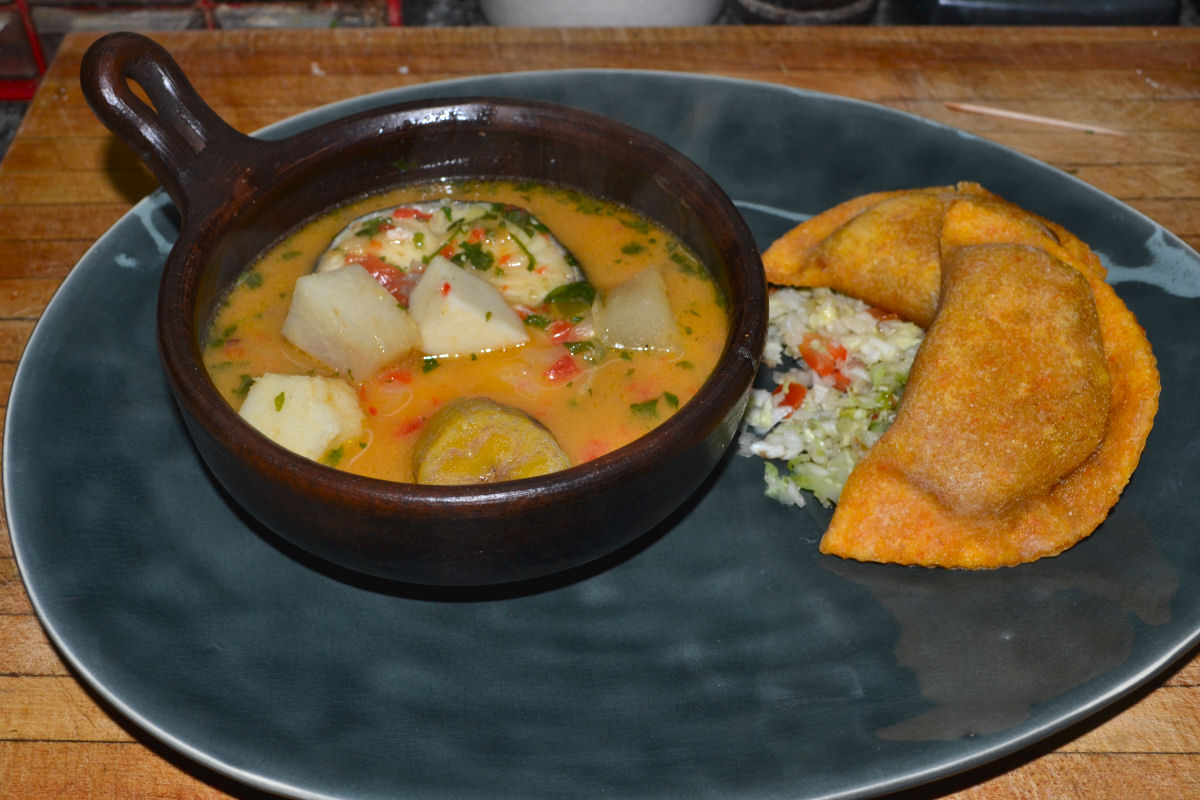
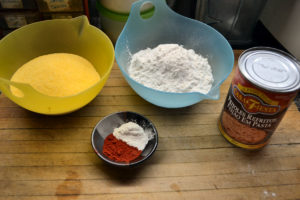
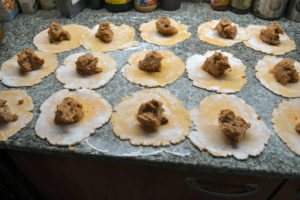
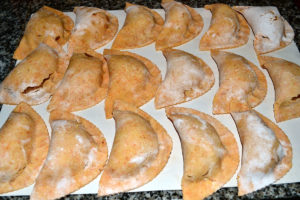
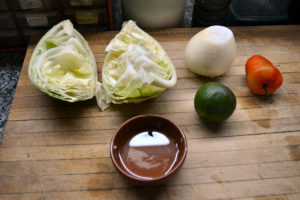
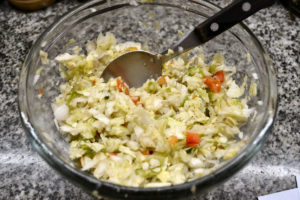
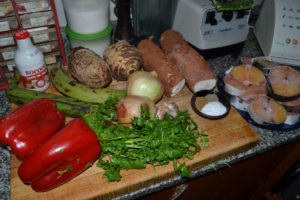
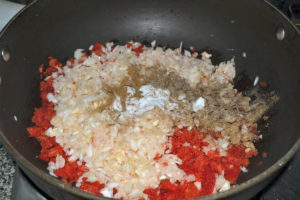
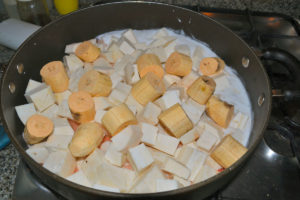
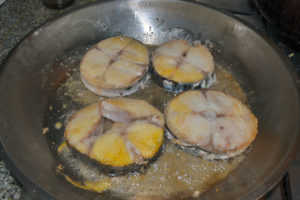
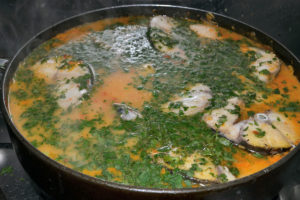
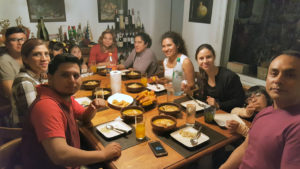
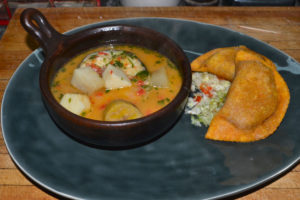
FYEO
https://www.youtube.com/watch?v=y3QjRpvxbkE&feature=youtu.be&t=4m13s
We were passing this one around on Facebook when it first came out, everyone in the restaurant business was making fun of her.
[…] … and returning to The Bread & Soup Project, with an entry from Belize, Serre with Panades. […]
[…] Next time we head to Central America for the first time in this series, and Belize! […]